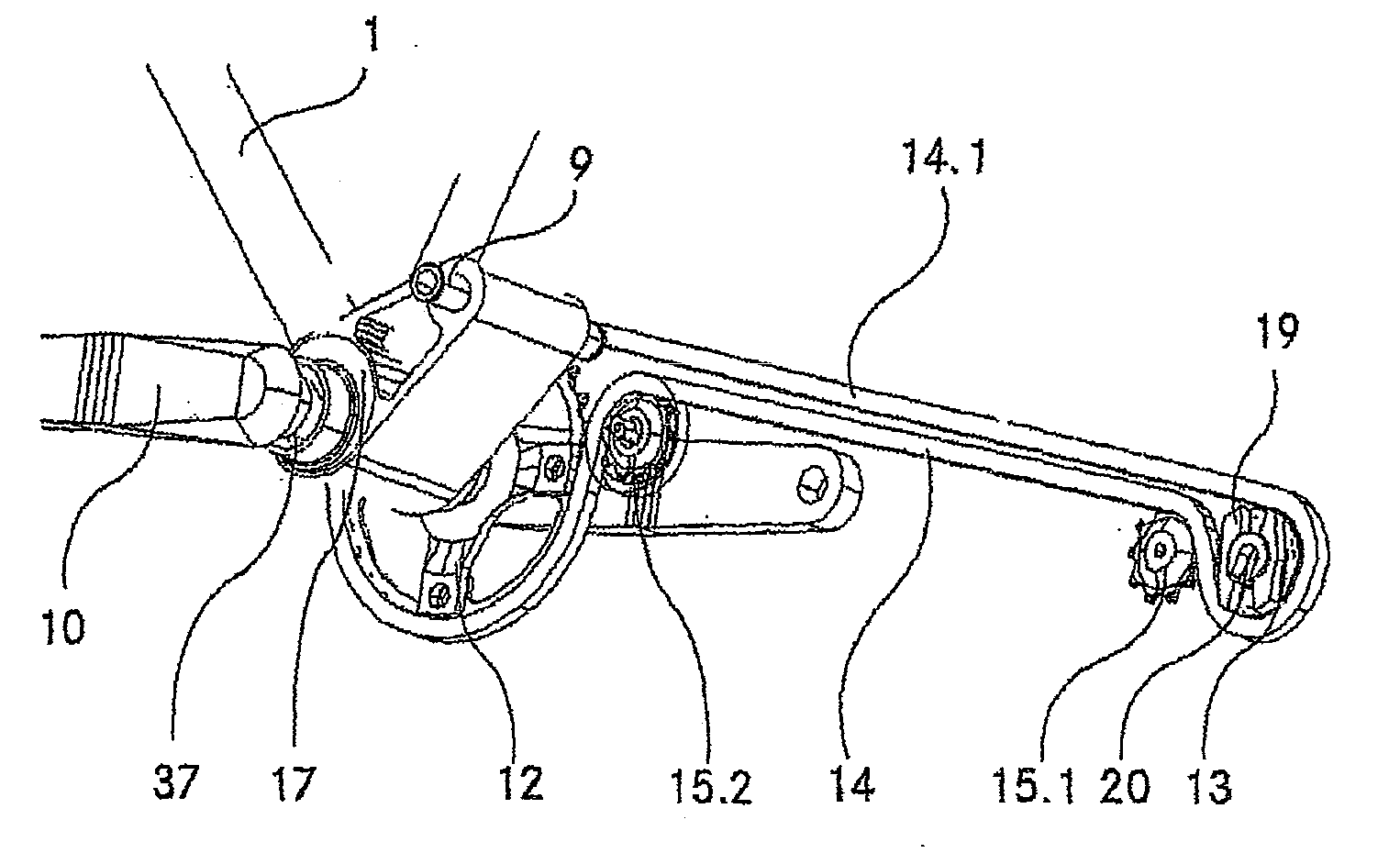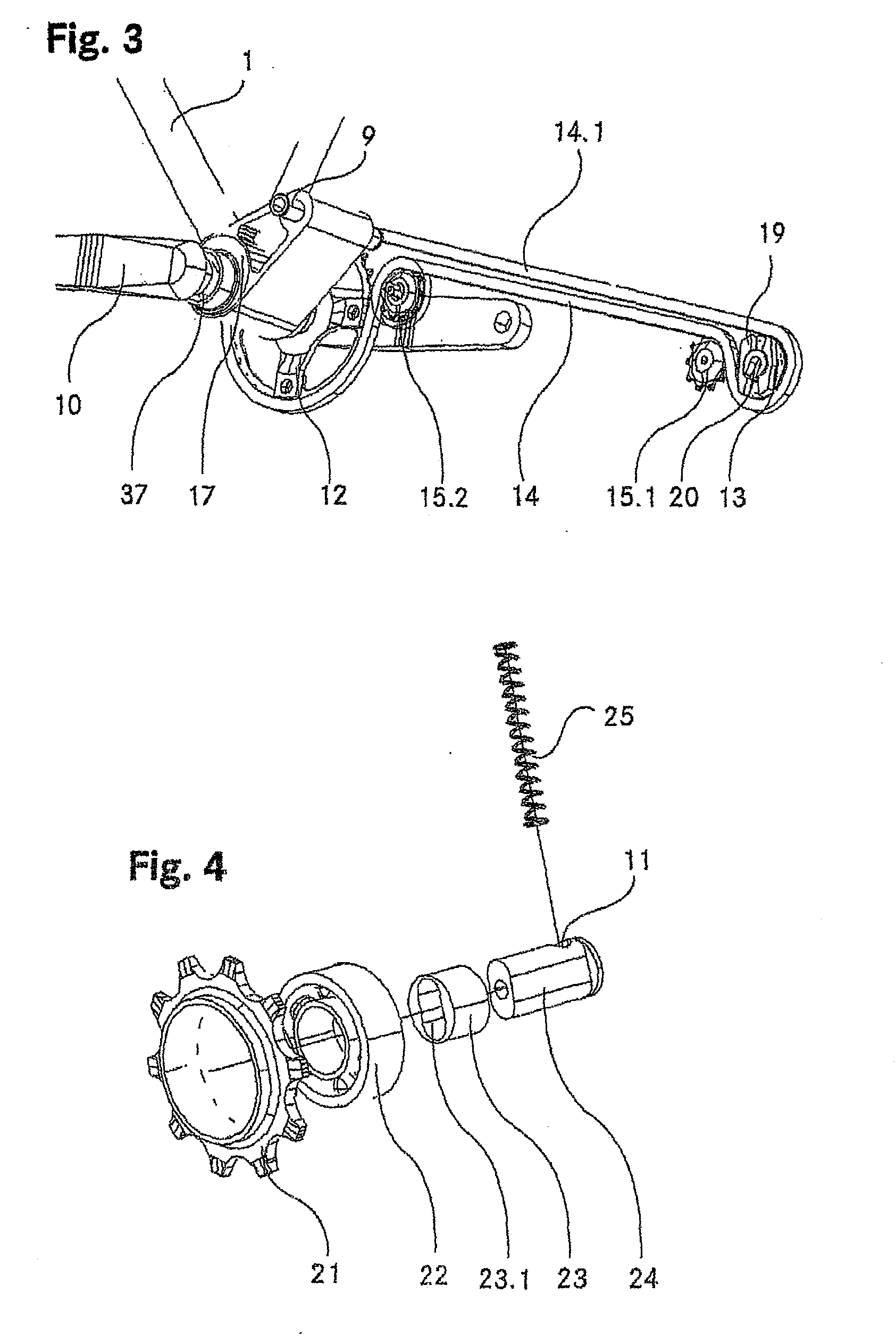Generally, current drive systems have a number of deficiencies.
The rear dérailleurs are in a very exposed position to the side of the rear wheel, with the result that they may be bent or torn off or their points of attachment to the frame bent or torn off by contact with large stones, by branches caught in the rear wheel or by the two-wheeled vehicle falling over, for example.
On bicycles with a hub gear, especially on those bicycles which have a mobile swing arm, there are often chain tensioners similar to dérailleurs, which are similarly susceptible to such external influences.
Since the chain in dérailleur gears is forced to move sideways under
high load over chain wheels, the chain is stressed in an unsuitable manner, and may be deformed or break.
The front chain wheels may strike an obstacle, such as a high step, when passing over it, and as a result teeth may snap off or entire chain wheels may be bent.
Moreover, the chain may jump off the chain wheel closest to the center of the wheel and, as a result, may
cut deep notches in the rear wheel spokes or even destroy them.
Furthermore, the chain may fall sideways off the chain wheels both at the rear wheel and at the
crank and become jammed between the chain wheels and the frame, thereby
cutting a deep notch or notches in said frame, something that may have a considerable effect both on
static strength and fatigue strength.
The anticorrosion layer on the frame is also damaged by the chain striking the chain stay, leading to
corrosion and hence weakening of a load-bearing component.
The positioning of the dérailleur relative to the chain wheels is often imprecise due to bent dérailleurs and to soiling, freezing or
corrosion of the dérailleur actuation mechanism, and this can lead to anything from unintended gear changes to the chain
jumping backward and forward in an uncontrolled manner between two adjacent chain wheels.
If the dérailleur is damaged, the dérailleur actuation mechanism is soiled, frozen or corroded or the load on the chain is high when shifting with the front dérailleur, the
spring force in the dérailleur, the strength of the dérailleur actuation mechanism or the strength of the user may not be enough to change between two gears.
The chain may jump completely or partially off the chain wheels and become jammed owing to shocks during riding, actuation of a dérailleur under load, incorrect spacing of chain wheels, a displaced lateral dérailleur limit stop, a bent dérailleur, backpedalling at a sharp chain angle, backpedalling with very dirty dérailleur rollers, or loss of tooth engagement at the front, for example.
On the one hand, jamming of the chain leads to an interruption in riding, but it can also damage load-bearing parts, unexpectedly lock up the rear wheel or lead to a sudden loss of resistance on the pedal, which may lead to a fall.
Owing to wear or when chain wheels are contaminated with
dirt,
snow or ice, the chain may skip individual teeth.
With dérailleur gears, it is not possible to change gear without turning the cranks.
In city traffic or after sudden braking maneuvers, however, it is often necessary to change from a riding gear to the starting gear when the bicycle is stationary.
The flexible chain tensioner gives the chain freedom of motion, and shocks and pedaling movements may lead to the formation of overruns in the chain which lock up the drive suddenly and can destroy the chain.
Malfunctions, especially those which require an immediate reaction by the rider, distract the rider of the two-wheeled vehicle from the
road traffic or the way, and this can lead to dangerous situations.
In the case of an
open design, the drive may be contaminated at any time by mud, sand or dust, and this leads to rapid wear and a reduction in efficiency owing to the fact that the
dirt particles are very hard and very small.
Moreover, the drive
train is exposed to rain,
snow or, when riding through streams, to the surrounding water, and as a result
lubricant in the drive is washed out within a short time.
Moreover, the
lubricant is washed out particularly quickly and thoroughly if the bicycle is washed using high-pressure cleaning systems.
The washing out of the
lubricant increases the friction between the individual components of the drive and thus also wear, and promotes
corrosion, and likewise leads to a loss of efficiency.
During this process, however,
brake linings or
brake disks may quickly be contaminated, thereby significantly impairing their operation.
Furthermore, the user's hands and clothes very often get dirty when applying oil or
grease to the drive.
Lubricant which has been washed out contaminates the environment with oil, and this is problematic particularly on unpaved paths in mountain areas.
In addition, the flexibility of the drive allowed by the chain tensioner gives rise to
noise owing to the fact that the chain and the dérailleur strike the frame.
A chain running at an angle imposes additional loads on the chain and the gearwheels in a particularly unfavorable manner in the case of certain gearwheel combinations.
Owing to the sensitivity of the drive to damage and environmental influences and because of the great
fragility of the systems, drives of this kind require a lot of maintenance.
When a wheel is being removed, as required, for example, in order to change a tire, there is a great risk that the hands will come into contact with the lubricant for the drive and get dirty.
The hands also quickly get dirty during other activities, such as transportation, regular maintenance work or the operation of a
shackle or cable lock.
Owing to the drive being exposed, clothes, especially trousers and dresses, are soiled by the lubricant for the drive.
Moreover, trouser legs, dresses or laces may be trapped between the front chain wheels and the chain and torn during the movement of the pedals.
Removing a wheel is complicated and time-consuming.
Some of today's drive systems are very expensive, for which reason they represent a high risk of theft.
There are no reliable methods of securing high-value hub gears, in particular.
Moreover, the drive is particularly susceptible to possible vandalism owing to its exposed position.
However, since the chain wheels of the various rear wheels are generally worn to different extents, the malfunctions described above multiply.
If the center of rotation of the mobile swing arm is below the load-bearing strand of the chain, a pull on the chain generally leads to an inward deflection of the mobile swing arm.
This “pedal kickback” leads to a change in chain tension during each deflection process, a change which is troublesome for the rider.
Consequently, it is not readily possible to prevent this effect in the case of gearwheels of different sizes such as those which are used in a dérailleur gear.
However, the external loads which occur with such positioning of the center of rotation act at an unfavorably
acute angle on the mobile swing arm, lowering its efficiency and reducing ride comfort and riding safety.
 Login to View More
Login to View More  Login to View More
Login to View More 


